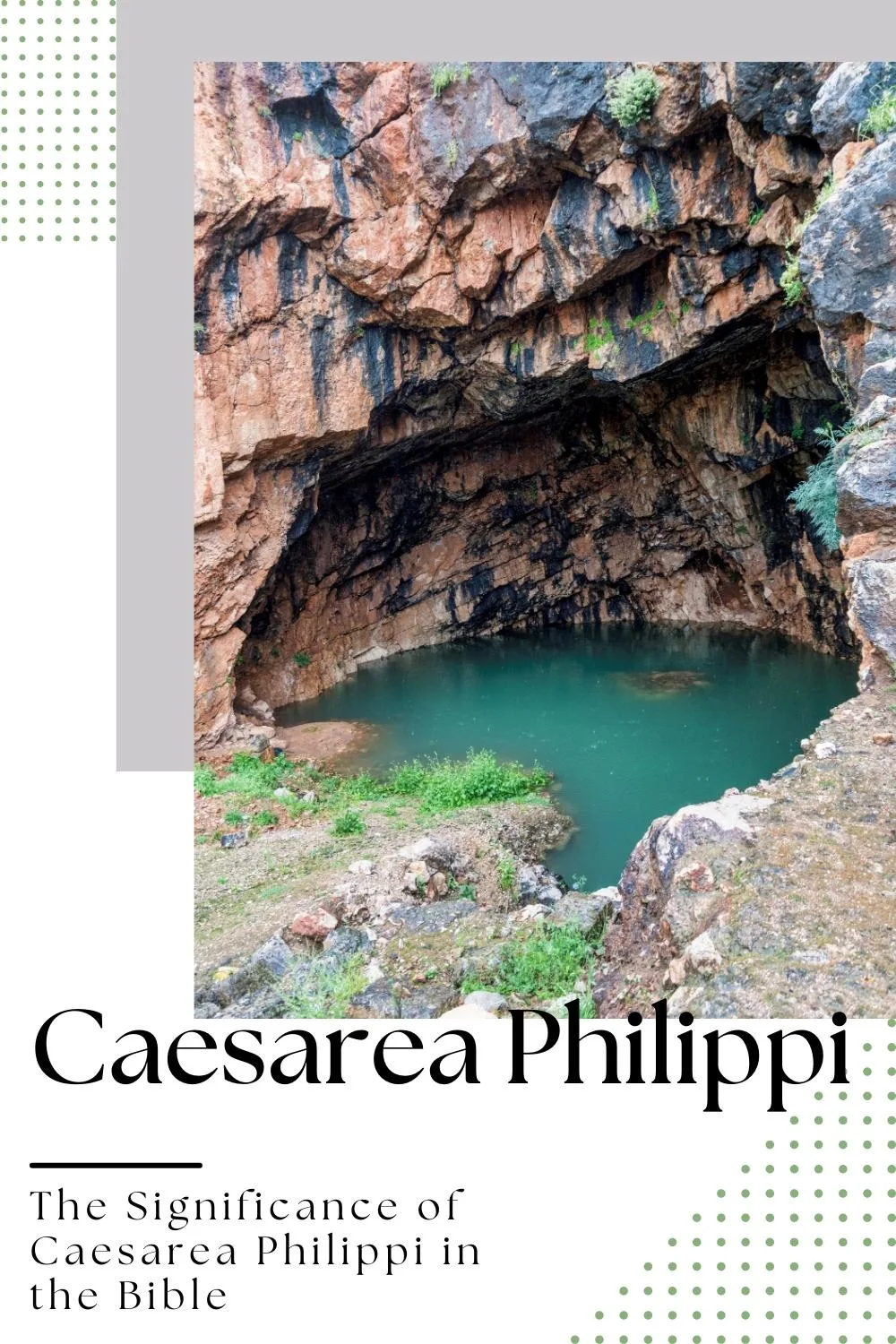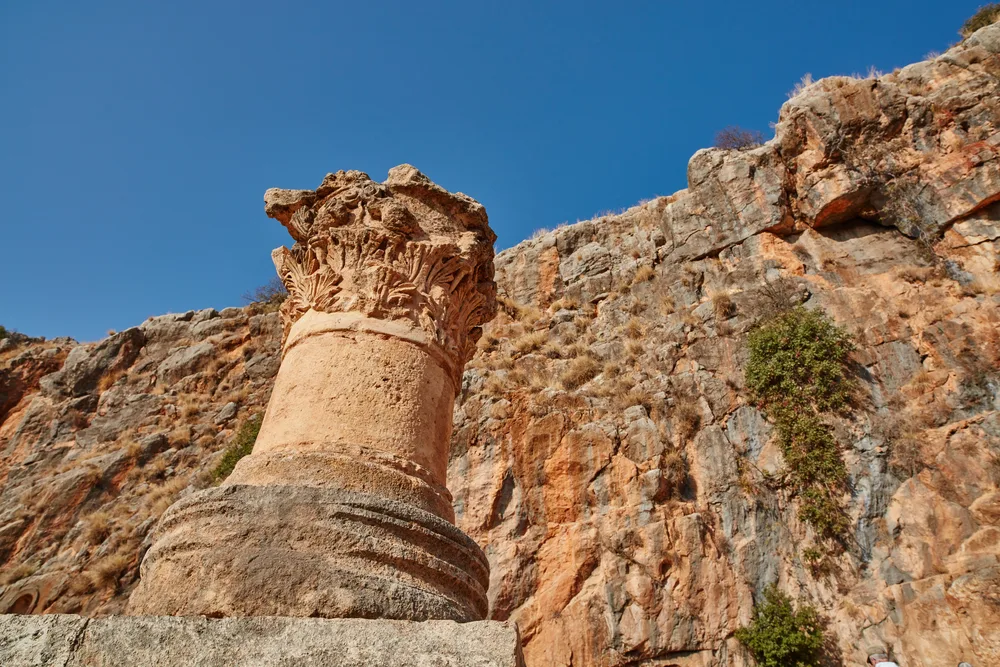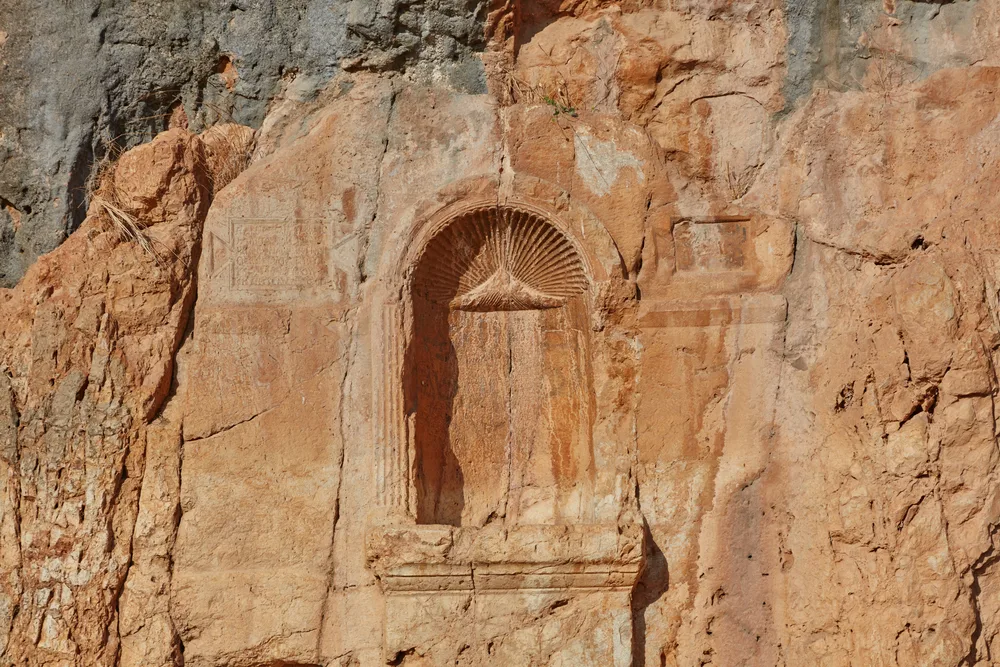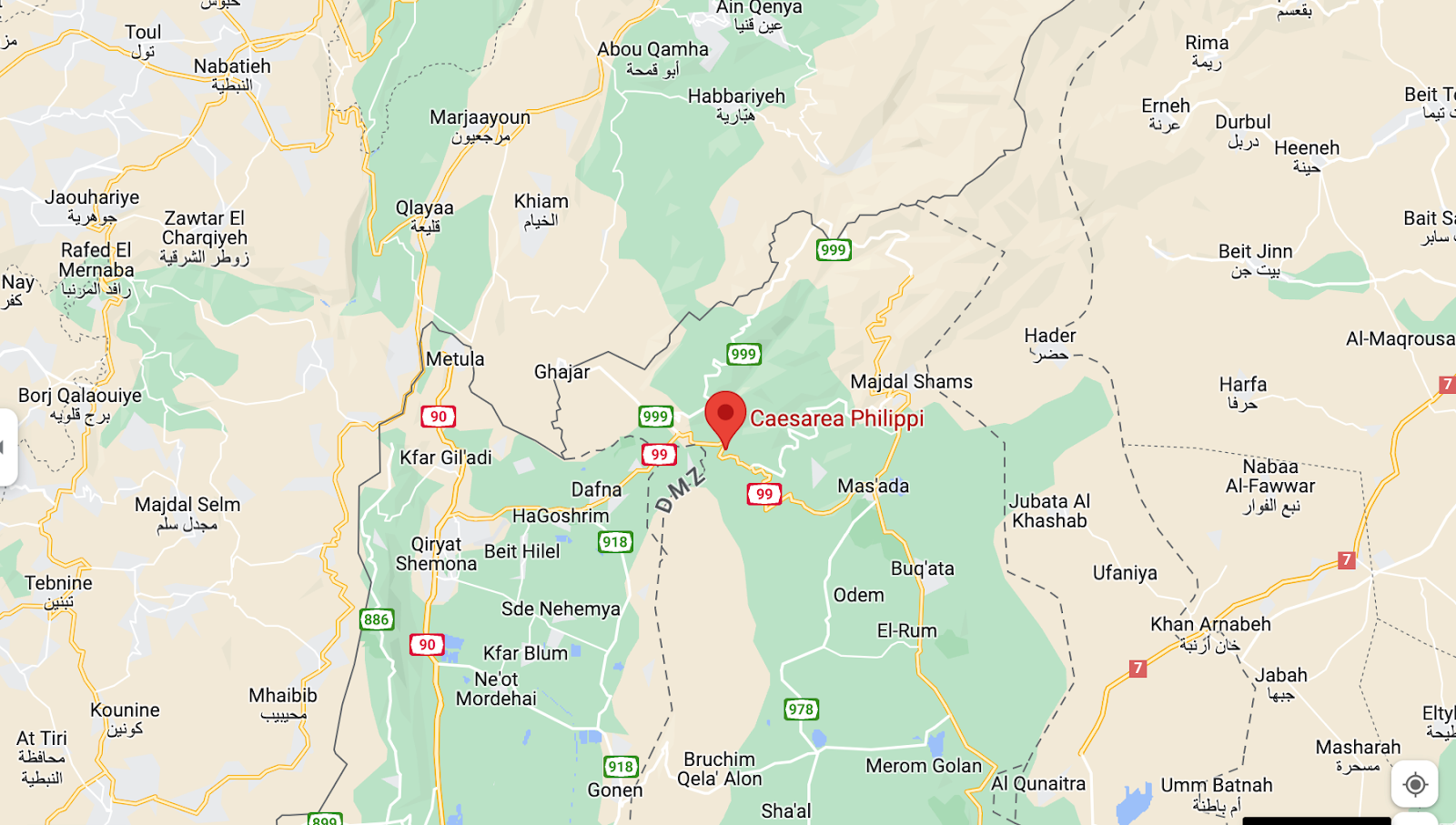This page/post may contain affiliate links. As an Amazon Associate, as well as an affiliate of other programs, this means if you purchase something using these links, I will receive a commission on qualifying purchases at no cost to you! For more detailed information, please visit our Affiliate Disclaimer page
Caesarea Philippi is a place of immense spiritual significance in modern Christianity. According to the Gospel of Matthew, it’s the location where Jesus received a monumental declaration from his apostle Peter regarding his divine identity.
Nowadays, this biblical site remains a powerful symbol of Christian faith and heritage. In this article, we’ll explore the history and region of Caesarea Philippi, its prominent role in biblical accounts, and its relevance in today’s Christian culture.
Drawing on archaeological and scriptural evidence, we’ll uncover the full significance of Jesus’s profound declaration and how it has been remembered in our present day.
With a little knowledge and insight, readers will soon appreciate why Caesarea Philippi is a sacred pilgrimage spot and a period in religious history that will live on through the ages. The gospel accounts reveal much of this.
Caesarea Philippi, located fifteen miles north of the Sea of Galilee in the foothills of Mount Hermon, has long been an important site for Christians.
It was from this city that Jesus asked, “Who do you say that I am?” (Matthew 16:13).

Now when Jesus came into the district of Caesarea Philippi, he asked his disciples, “Who do people say that the Son of Man is?”
Matthew 16:13 (ESV)
Not only is its historical significance deeply meaningful, but it also is the source of the Jordan River – the largest natural spring in the region.
The form you have selected does not exist.
The God Pan Worshipped At Banias
At the highest point of Mount Hermon, snowmelt seeps through the ground and begins to form the source of the Jordan River. Referred to by Josephus as the fountain of the Jordan, the Jordan River finds its headwaters in a cold and crystal-clear stream that bubbles from a large cave.
For Christians, the Jordan River is a sacred symbol of new beginnings and a reminder of Jesus’ baptism in its waters.
Archaeology reveals a sort of type of pagan temples, an open-air shrine, the cave of Pan, dedicated to the half-man, half-goat Greek gods Pan, right above the cave where the water flows. Once again pagan worship rears its ugly head.
Niches on the side of the cliff still hold statues of Pan, who famously played the panpipe. For Christians, the discovery reaffirms the Old Testament’s description of the pool.
We can thank the god Pan for the word “panic,” and it’s easy to see why! Famed for his hedonistic pleasures, Pan once pursued a nymph called Syrinx, but she transformed into a clump of reeds to avoid him. As the legend goes, Pan fashioned a set of panpipes from the reeds, giving us the enchanting instrument. It’s no surprise that Peter Pan, the beloved Walt Disney character, plays the flute. (Sorry, parents.)

Two Names, One Place
- The site has been identified in Scripture with several names:
- Baal-gad (Joshua 11:17; 12:7; 13:5)
- Baal-hermon (Judges 3:3)
- Caesarea Philippi (Matthew 16:13)
Today, the place is known by two names for two reasons:
- Banias–As the ancient city of Panias, located at the base of Mount Hermon, lacked an equivalent for the letter “P” in Arabic, its name changed to Banias—remaining to this day.
- Caesarea Philippi has a storied history stretching back to 197 BC when Antiochus III defeated the Egyptians at Banias and paved the way for Antiochus IV’s persecution of the Jews. The Maccabean Revolt followed and in 20 BC, Caesar Augustus gave the area to Herod the Great, who built a magnificent temple of white marble in the emperor’s honor.
Eighteen years after King Herod’s reign, the son of Herod, Philip inherited the site and named it Caesarea. Philip was keen to distinguish the place from his father’s harbor in the seacoast that had a similar name, so he combined his own name with it: Caesarea Philippi.
In the 12th century, the Crusaders set up a strategic outpost on the site of the Holy Sepulchre in Jerusalem to ward off the Sultan of Damascus. To bolster their defense, they occupied the high vantage point of nearby Nimrod’s Fortress.
Afterward, the Christians and Muslims agreed to a compromise and divided the fertile plains in the vicinity.
The Significance of Caesarea Philippi
At the small village of Caesarea Philippi, Jesus made a groundbreaking declaration to his disciple, Peter.
And I tell you, you are Peter, and on this rock I will build my church, and the gates of hell shall not prevail against it.
Matthew 16:18 (ESV)
This passage marks the debut of the term “church” in the New Testament, offering invaluable insight into the importance of Christian faith and community.
The word carries a deep sense of sacrality and invites us to reflect on the profound power an organized church can have in the lives of believers.
In the Gospels of Matthew and Mark, Jesus asked his disciples, here, at Caesarea Philipp, “Who do people say I am?” leading up to the profound statement that followed. For Christians, this question remains timeless, and is a reminder of Jesus’ place in their lives.
Now when Jesus came into the district of Caesarea Philippi, he asked his disciples, “Who do people say that the Son of Man is?”
Matthew 16:13 (ESV)
And Jesus went on with his disciples to the villages of Caesarea Philippi. And on the way he asked his disciples, “Who do people say that I am?”
Mark 8:27 (ESV)

When they were asked who Jesus was, the disciples gave varying answers: John the Baptist, Elijah, and one of the prophets. But Jesus pushed them further, inquiring, “Who do you say I am?”
With seemingly no clear answer, Jesus’ question tested the disciples’ faith and gave them an opportunity to recognize Him as the Son of God – the Messiah promised to Christians for centuries.
Peter spoke up:
Simon Peter replied, “You are the Christ, the Son of the living God.”
Matthew 16:16 (ESV)
The bedrock of Jesus’ church was built upon a timeless truth. It all began in the ancient city of Caesarea Philippi, where Jesus tasked his followers with a mission that would shape Christianity for generations to come.
The God-Man Asks A Question Near Caesarea Philippi
Jesus and His twelve disciples journeyed to the Gentile region of Banias/Caesarea Philippi with a powerful question: “Who do you say that I am?” To the followers of Jesus — all of them devout Jews — the question may have seemed strange and out of place. After all, this was a region they would have seen as steeped in idolatry and far from the abode of the Lord.
But Jesus knew that He was the fulfillment of Old Testament prophecy and He wanted His disciples to fully understand who He was. This was an invitation to a much deeper relationship with Him, and to a clearer understanding of their calling and purpose in His mission.
This was a turning point in the life of the disciples and of the early church. Jesus was calling for His followers to accept and embrace the truth of who He was.
Who do people say that the Son of Man is?
The crowds initially saw Jesus as just another moral teacher, and even considered him a prophet. But, Jesus challenged them to find a deeper meaning in his teachings by narrowing the question: “Who do you say that I am?”
This question caused the people to take pause and reconsider who Jesus was, and the implications of His wisdom.
Ultimately, the answer has been the same for Christians for centuries: Jesus is the living, suffering, and victorious Son of God.
But who do you say that I am?
His disciples responded they believed He was the Messiah of God
Now when Jesus came into the district of Caesarea Philippi, he asked his disciples, “Who do people say that the Son of Man is?” And they said, “Some say John the Baptist, others say Elijah, and others Jeremiah or one of the prophets.” He said to them, “But who do you say that I am?” Simon Peter replied, “You are the Christ, the Son of the living God.”
Matthew 16:13-16 (ESV)
Why did Jesus make the journey to Caesarea Philippi, a lesser-known city located in a quiet corner of the Holy Land? While He usually preached to larger crowds in bustling cities, He may have sought out this peaceful spot to spend some time with His disciples.
It was a beautiful, tranquil spot, perfect for a peaceful escape and a time of reflection with His closest followers.
Jesus’ mission to spread the word of God extended throughout Galilee. In town after town and village after village, Jesus preached the gospel and established His ministry (Matthew 4:23, 9:35). He could not overlook Caesarea Philippi.
And he went throughout all Galilee, teaching in their synagogues and proclaiming the gospel of the kingdom and healing every disease and every affliction among the people.
Matthew 4:23 (ESV)
And Jesus went throughout all the cities and villages, teaching in their synagogues and proclaiming the gospel of the kingdom and healing every disease and every affliction.
Matthew 9:35 (ESV)
In Caesarea Philippi, Jesus showed us that He is always mindful of those in poverty, those overlooked, and those who face marginalization.
Our Lord’s visit to this city stands as a reminder that He is ever-present in the lives of those without a voice. He knows their pain, and He hears their cries. In a world where the poor are often ignored, Jesus gives us hope.
Come to me, all who labor and are heavy laden, and I will give you rest.
Matthew 11:28 (ESV)
His birth was first announced to a group of humble shepherds, as recorded in Luke 2:8-12, and one of His most world-altering declarations was made at Caesarea Philippi, to a group of unlikely disciples.
And in the same region there were shepherds out in the field, keeping watch over their flock by night. And an angel of the Lord appeared to them, and the glory of the Lord shone around them, and they were filled with great fear.
Luke 2:8-12 (ESV)
And the angel said to them, “Fear not, for behold, I bring you good news of great joy that will be for all the people. For unto you is born this day in the city of David a Savior, who is Christ the Lord. And this will be a sign for you: you will find a baby wrapped in swaddling cloths and lying in a manger.
Jesus continually demonstrated the truth of Paul’s words in 1 Corinthians 1:27–29:
But God chose what is foolish in the world to shame the wise; God chose what is weak in the world to shame the strong; God chose what is low and despised in the world, even things that are not, to bring to nothing things that are, so that no human being might boast in the presence of God.
1 Corinthians 1:27-29 (ESV)
Caesarea Philippi was an unremarkable location until Jesus Christ chose it as the spot to announce the establishment of His church, thus giving it eternal significance in the Christian faith.
Caesarea Philippi played a special role for Jesus in the synoptic gospels of Matthew, Mark, and Luke. As the northernmost area of Jesus’ wanderings, he posed the challenging question of who he was to his disciples here (Matthew 16, Mark 8, and Luke 9). Peter’s response, that Jesus was the Christ, shifted the focus of Jesus’ path up to the cross in Jerusalem, challenging his followers to take up their own crosses to follow him.
Located at the northernmost edge of Jesus’ travels was Caesarea Philippi, situated in Galilee within the land allotted to the tribe of Naphtali. The sparsely populated area was recorded as being visited by Jesus only once, despite its location in Judea close to the border of the Mediterranean Sea.
Where is present day Caesarea Philippi?
Exploring the ruins of Caesarea Philippi, visitors of the archaeological site at the foot of Mount Hermon can find a unique blend of artifacts from different eras, including ancient structures, palaces, an operational water mill, and the famous Grotto of Pan.
Located at the headwaters of the Jordan River, you can receive a refreshing baptism of the Hermon River’s water. Nestled in the hills of the Golan Heights along the Syrian and Lebanese border, this holy site is a must-see for all Christians.
Also known as Baal-gad, Banias, Baniyas, Banyas, Barias, Belinas, Caesarea Neronias, Caesarea of Philip, Caesarea Paneas, Caesarea Panias, Caesareia Sebaste, Keisarion, Kisrin, Medinat Dan, Mivzar Dan, Neronias, Pamias, Paneas, Paneias, Paneion, Panias, Panium
Caesarea Philippi (Banias) on the Map:

The region now known as Caesarea Philippi has been a spiritual and historical touchstone throughout the centuries. From its origin as the pagan worshipping ground of Pan in the 1st century B.C.E., to its acceptance as a Jewish pilgrimage site two thousand years later, Caesarea Philippi has been a point of cultural encounter.
But most notably, it was here that Jesus Christ declared to Peter “On this rock I will build my church.” Although its current condition is fragmented and in much need of archaeological research, Caesarea Philippi’s significance as a site of faith, discovery, and a shared past is undeniable.
Today, this ancient location serves as a reminder to each of us that our choices can shape not only our lives but our world and the lives of others. Here’s to building a better tomorrow, one rock at a time.
Take it Deeper with this Short Devotional for Caesarea Philippi (Banias)
Read Matthew 16:13-17:2 and Psalm 42:7-11.
Peter, the disciple, courageously answered Jesus’s question with unfaltering faith: “You are the Christ, the Son of the Living God”. His declaration marked a pivotal moment in Christian history, demonstrating the disciples’ unwavering belief in Jesus’s divinity.
Simon Peter replied, “You are the Christ, the Son of the living God.”
Matthew 16:16 (ESV)
Jesus didn’t just share who He was but what He had come to do. He proclaimed the astounding message of His death and resurrection. Peter, however, would not accept this and longed for a promised kingdom instead.
On the holy mountain of Transfiguration, Jesus demonstrated His identity as the Messiah. Yet, first He must bear the burden of the cross, revealing His destiny as a suffering savior.
For Christians, this is a powerful reminder that God’s divine power is found in the humility of the cross.
Like Peter, the cross highlights our struggle to accept life’s uncertainties. We’re often tempted to strive for glory and the good stuff right now, yet Jesus reminds us that true fulfillment lies beyond the grave, save for the resurrection.
For those in the Christian faith, the cross serves as a powerful reminder that faith and obedience are essential for a life of true abundance.
When the burden of the cross seems too heavy to bear, the words of the sons of Korah can provide Christians with a refreshing sense of hope and strength.
Rich with spiritual insight and Biblical truth, these powerful psalms bring peace, comfort, and assurance to those who are struggling – an assurance that our burdens are never too great for God to bear.
As with a deadly wound in my bones,
Psalm 42: 10-11 (ESV)
my adversaries taunt me,
while they say to me all the day long,
“Where is your God?”
Why are you cast down, O my soul,
and why are you in turmoil within me?
Hope in God; for I shall again praise him,
my salvation and my God.
The form you have selected does not exist.
You may enjoy this video with footage from Caesarea Philippi:
Or one of these recommended resources.
Caesarea Philippi: Banias, The Lost City of Pan by John Wilson
Caesarea Philippi: And the Banias nature reserve (History Comes Alive in Israel) by Sarit Gani
I know you’ll also love the ArtzaBox, a quarterly subscription box with items from various regions of Israel. Use code: Noble 25 for 25% off!
If you are interested in joining us on a group trip to the Holy Land in September 2024. Great group rates and an amazing trip to walk where Jesus walked. Email [email protected] for a brochure, itinerary, and more info.
ESV – “Scripture quotations are from The ESV® Bible (The Holy Bible, English Standard Version®), copyright © 2001 by Crossway, a publishing ministry of Good News Publishers. Used by permission. All rights reserved.”

